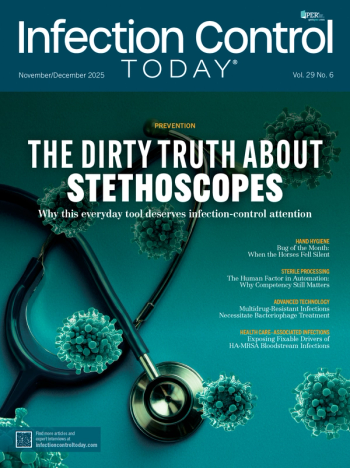
- Infection Control Today, November/December 2025 (Vol. 29 No.6)
- Volume 29
- Issue 6
The Dirty Truth About Stethoscopes: Why This Everyday Tool Deserves Attention
Much is discussed about stethoscopes, the "third arm" of clinicians, but what about the risk of spreading health care-associated infections?
This is the first in a 3-part series on the panel about stethoscopes.
Stethoscopes are the third arm of the clinician—reached for instinctively, used dozens of times per shift, and rarely the star of infection prevention policies. Yet a lively roundtable of clinicians and infection preventionists (IPs) makes a compelling case that this everyday tool can be a stealth vector for transmission, and that fixing the problem will require more than wipes on a cart. It will require muscle memory, clearer guidance, practical products, and a culture that treats stethoscope hygiene with the same importance as hand hygiene.
This was a frank discussion that moved from outbreak investigation to human behavior, from device manufacturer instructions for use (IFUs) to dwell times, from single-use disposables to UV gadgets—and, ultimately, to culture, trust, and training that begins far upstream.
Speakers included:
- Elsy Mady, MSN, BSN, RN, CIC, independent infection preventionist consultant
- Aaron Woodall, MPH, CIC, LTC-IP, chief of infection and control for the US Department of Veterans Affairs
- Peter Graves, MSN, RN, CNOR, independent perioperative consultant, speaker, and peer-reviewed writer
An Outbreak With an Unlikely Culprit
The conversation opened with a vivid case study. Mady described investigating an alarming cluster of cases at a small, 100-bed hospital in Lebanon during the early months of the COVID-19 pandemic. “I started receiving positive cultures…an Acinetobacter resistant to all antibiotics,” she recalled. Because the hospital had previously battled outbreaks from the same organism, “[only] 1 positive result was enough to create an outbreak alert.”
Her team launched a comprehensive search, including environmental culturing, [heating, ventilation, and air conditioning] checks, staff scrubs and fingernails, and respirators—“Everything possible that could harbor this bacteria.” When nothing explained the resurgence, a pulmonologist caring for the affected patients handed Mady her stethoscope. “I dismantled it piece by piece and sent it to culture,” she said. “The surprise was that the bacteria were inside the stethoscope…not on the outside, but inside.”
The response was decisive: Collect every stethoscope, disassemble it, clean, disinfect, sterilize, and then reassemble it. “We stopped this outbreak,” Mady reported. The lesson stuck. When she later asked US physicians how they managed stethoscope hygiene, she often heard, “I put it on the patient’s clothes, so I don’t need to disinfect.” Her reply was blunt: “How do you know your patient’s clothes are clean?”
The Trouble With “Wipe-and-Go”
Operating room leader Graves immediately connected Mady’s discovery to surgical practice. “As an operating room [OR] nurse, that’s something we’re always concerned about: lumens and nooks and crannies,” he said. Surface cleaning alone won’t cut it. “To thoroughly clean something, you have to disassemble it—not just wipe the outside off. It’s the ‘wax on, wax off’ idea: thorough cleaning, not topical cleaning.”
But thoroughness collides with reality. Woodall, an infection-prevention leader, cautioned that expecting providers to disassemble stethoscopes after each use is impractical. “The more you tack on to the daily work, the more it gets pushed off,” he said. “Most providers are already behind. Are you going to get them to stop and take apart a Littmann?” Even when policies exist, “it’s not going to be met with a friendly face.”
The group agreed that evidence exists—in abundance—of contamination, even if causal chains to specific infections are rare. Graves had scanned 16 studies before the call: “Depending on location and how often they’re cleaned, stethoscopes are contaminated 40% to 100% of the time.” Yet he confessed he couldn’t think of a guideline that frames stethoscope cleaning with the same clarity and urgency as hand hygiene. “Maybe we need to codify it,” he suggested.
Guidance Gaps, IFUs, and the Dwell-Time Blind Spot
If guidelines are thin, IFUs can be maddeningly vague. “Most providers default to the Littmann,” Woodall noted. “Their IFU talks about 70% [isopropyl alcohol]. And then they do the irritating thing: ‘mild soap and water.’” Hospitals often don’t stock wipes clearly labeled as 70% isopropyl alcohol, he added, “so any hospital that doesn’t carry something specific to that…most aren’t going to use it correctly.”
The group raised a second, ubiquitous problem: failure to respect dwell time—the time a disinfectant must remain wet on a surface to achieve its claim. The moderator shared a personal moment at an eye clinic: “She opened a wipe and swabbed the chin rest. She said, ‘Go ahead.’ I said, ‘I’m not touching that until it dries.’ …People don’t understand: if you don’t let it dry, it’s not killing anything.”
Woodall agreed: “Cleaning is not disinfecting—and that’s the piece generally missed. You have to hit your dwell time. Otherwise, you’re not doing anything, and you’re putting people at risk.” Graves added a cautionary tale: a center using wipes with a 10-minute dwell time, but staff only allowed 2 minutes before toweling dry. “It defeats the purpose.”
Mady’s bottom line for product selection was practical and familiar to IPs: “Follow the IFU for the disinfectant you have.” Hydrogen peroxide, quaternary ammonium compounds, and alcohol, “every hospital uses something different. If the disinfectant is tested for the stethoscope, use it.”
Ultraviolet Devices and the Limits of Line-of-Sight
Could engineering controls help? Phone-sanitizing boxes and small UV chambers promise quick and consistent disinfection without the need for handling chemicals. Graves asked for reactions. Woodall was cautious: “It depends on the device and the UV type. Some could be valuable, while others probably are not. And behavior fades—initial use is high, then it tapers. It’s like Christmas presents.”
The moderator highlighted a fundamental constraint: “UV-C only works on surfaces it can reach. It won’t do a darn thing for the issue [Mady] had—contamination inside the stethoscope.” Graves concurred: “It only gets where the light shines.”
Disposable Stethoscopes: A Green and Quality Dilemma
What about single-patient, disposable stethoscopes? They offer a clean slate and eliminate the need for shared devices. In practice, the panel found them wanting. “If you have a really good process, it can work,” Woodall said, “but the cost incurred can be high.” Graves added the OR perspective: “Anesthesia is not fond of those. The quality is significantly less. And the tubing is often too short.”
Mady raised waste as another concern. “If a hospital pays for waste, imagine the volume from these items. And if we find them in the garbage—not hanging where they belong—you don’t know where that stethoscope was.” On balance, the panel identified narrow use cases but concluded that disposables are not a scalable solution for high-acuity, noisy environments.
Human Factors: Fear Fades, Habits Stick
Why is adherence so difficult? Partly, fear fades. During COVID-19’s early surge, “everybody paid attention to all the details,” Mady said. “When the pandemic was declared over, we’re back to business, and everyone is not paying attention.” Woodall put it starkly: “Easy times breed soft minds.” The public doesn’t grasp the day-to-day reality of antimicrobial resistance; absent a crisis, risk feels abstract.
Training gaps also matter. “Medical schooling doesn’t address infection prevention in a manner it should,” Woodall argued. Clinicians know how to assess a patient’s infection, “but not the small things like dwell time.” “You get people from [gastrointestinal] or [genitourinary], where they're using a lot of scopes and instruments. They understand the disinfection portion and sterilization a lot more than some of the other areas that have to kind of speed through what they're doing just to get things turned over.”
The group returned repeatedly to muscle memory—a concept Graves illustrated with his daughter’s volleyball team. “They practice and practice, so they know instinctively what to do in a game,” he said. “We try to do that with hand hygiene. We need the same for stethoscope hygiene.”
Beyond the Walls: Culture, Trust, and Early Education
For sustainable change, the panel returned to the topic of culture. “It comes down to building a culture of trust,” Woodall said. It must be trust that infection prevention guidance protects patients, staff, and families. “infection prevention doesn’t stop at the hospital walls. It continues into the community.”
Mady argued for starting far earlier than orientation: “To build a pianist, you start early. The same with infection prevention.” She envisions incorporating age-appropriate concepts into K-12 education and establishing dedicated courses in nursing and medical schools. “By hearing it over and over and practicing it, we will end up making a change in the culture.”
Graves framed the destination succinctly: “Do the right thing when no one’s looking.” That means aligning stethoscope hygiene with the “high reliability organization” pillars many hospitals espouse—preoccupation with failure, sensitivity to operations, and commitment to resilience.
The Bow on It
Stethoscopes will always be in the pockets of health care workers, around their necks, and on their patients. The question is whether policies, products, and habits will catch up with their risk profile. The roundtable’s consensus is not to overcomplicate it: Match IFUs with available disinfectants, honor dwell times, build small routines at the right moments, make contamination visible, and foster a culture where cleaning the stethoscope is as reflexive as sanitizing hands.
Or, in Woodall’s bracing shorthand about human nature: “Easy times breed soft minds.” IPs have an antidote: steady, visible, practical habits that harden into muscle memory—one wipe, one dwell time, one patient at a time.
Articles in this issue
Newsletter
Stay prepared and protected with Infection Control Today's newsletter, delivering essential updates, best practices, and expert insights for infection preventionists.





